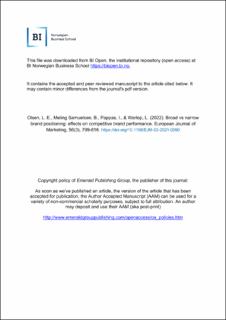Broad vs. Narrow brand positioning: Effects on competitive brand performance
Peer reviewed, Journal article
Accepted version
Permanent lenke
https://hdl.handle.net/11250/3091623Utgivelsesdato
2022Metadata
Vis full innførselSamlinger
- Scientific articles [2173]
Sammendrag
Purpose –Brand managers can choose among two fundamentally different brand positioning strategies. One is a broad brand strategy, focusing on many favorable brand associations. The other is a narrow brand strategy, focusing on just a few and thus more mentally accessible associations. Building on associative memory theory, the current article examines which of these brand positioning strategies performs better under dynamic market conditions. Design/methodology/approach – Three experiments test the effect of brand positioning strategy on memory accessibility and competitive brand performance. Study 1 tests how brand strategy (broad vs. narrow) affects defensive brand performance. Study 2 tests how broad vs. narrow brands perform differently in a brand extension scenario (offensive brand performance). Study 3 uses real brands and situation-based attributes as stimuli in a defensive scenario. Findings – The results show that a narrow brand positioning strategy leads to a competitive advantage. Narrow brands with fewer and more accessible associations resist new competitors more easily and have higher brand extension acceptance than do broad brands. Research implications – The article shows how to use accessibility as evidence of associative strength and test how accessibility influences competitive brand performance in a controlled experimental context. Practical implications – Brand managers would benefit from a narrow brand positioning strategy in accordance with the USP school of thought used by many marketing practitioners. Originality – The paper demonstrates that narrow brand positioning performs better than broad brand positioning in dynamic markets, and to our knowledge is the first to do so.

